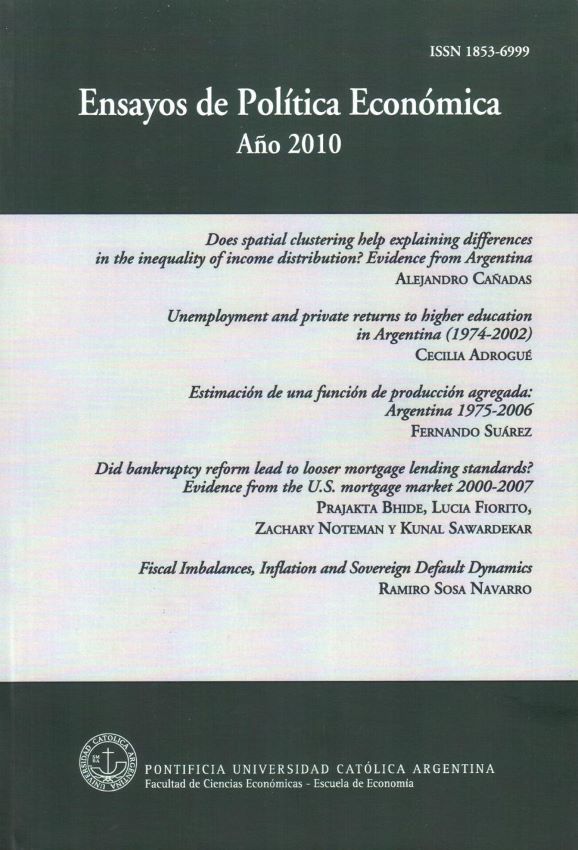Does spatial clustering help explaining differences in the inequality of income distribution? Evidence from Argentina
Keywords:
Inequality in income distribution, spatial autocorrelation, ArgentinaAbstract
This paper analyzes the relationship between the spatial clustering of income distribution and
inequality in the provinces of Argentina. The goal of the paper is to use spatial techniques to analyze to what extent the spatial clustering of income distribution affects the inequality of income distribution in a regional context of Argentina. In general, the literature of inequality implicitly considers each region or province as an independent entity and the potential for observational interaction across space has often gone ignored. However, spatial autocorrelation occurs when the spatial distribution of the variable of interest exhibits a systematic pattern. I compute three measures of global spatial autocorrelation: Moran’s I, Geary’s c, and Getis and Ord’s G, as the degree of provincial clustering between 1991 and 2002. The paper’s main conclusion is that there is evidence that relatively high (low) unequal provinces tend to be located nearby other high (low) unequal provinces more often than would be expected due to random chance. Therefore each province should not be viewed as an independent observation, as it has been implicitly assumed in previous studies of regional income inequality.
Downloads
References
Acemoglu, D., S. Johnson, and J. Robinson (2002). Reversal of Fortune: Geography and Institutions in the Making of the Modern World Income Distribution. The Quarterly Journal of Economics, 117(4), 1231-1294.
Alesina, A., and R. Perotti. (1994). The Political Economy of Economic Growth: A Critical Survey of the Literature. World Bank Economic Review, 3, 351–371.
Atkinson, A. (1970). On the Measurement of Inequality. Journal of Economic Theory, 2, 244-263.
Atkinson, A. (2003). Top Incomes in the United Kingdom over the Twentieth Century. U.K.: University of Oxford.
Barro, R. J. (2000). Inequality and Growth in a Panel of Countries. Journal of Economic Growth 5(1), 5-32.
Bértola, L. (2005). A 50 años de la curva de Kuznets, una reivindicación sustantiva: distribución del ingreso y crecimiento económico en Uruguay y otros países de nuevo asentamiento desde 1870. Instituto Laurentano Figuerola de Historia Económica, Working Paper Series 05-04(Universidad Carlos III de Madrid).
Bértola, L., and J.G. Williamson (2003). Globalization in Latin America before 1940. National Bureau of Economic Research, Working Paper 9687. Cambridge, MA: National Bureau of Economic Research.
Bourguignon, F. (2004). The Poverty-Growth-Inequality Triangle. The World Bank Policy Research Working Paper (28102).
Bourguignon, F., and C. Morrisson (2002). Inequality among World Citizens: 1820-1992. The American Economic Review, 92(4), 727-744.
Calvo, E., J. Torre, and M. Szwarcberg (2002). The New Welfare Alliance. Buenos Aires: Universidad di Tella, Department of Political Science.
Cowell, F. (1998). Measurement of Inequality. Paper presented at the London School of Economics and Political Science, London.
Cowell, F. A., and A. Jenkins. (1995). How Much Inequality Can We Explain? A Methodology and an Application to the United States. Economic Journal, 105, 421-430.
De Ferranti, D., G. E. Perry, F. Ferreira, and M. Walton. (2004). Inequality in Latin America & the Caribbean: Breaking with History? Washington D.C.: World Bank.
Easterly, W. (2001). The Middle Class Consensus and Economic Development. Journal of Development Economics, 6, 317–335.
Engerman, S., and K. Sokoloff. (2006). The Persistence of Poverty in the Americas: The Role of Institutions. In S. Bowless, S. Durlauf, and K. Hoff (ed.), In Poverty Traps: Forthcoming.
Forbes, K. J. (2000). A Reassessment of the Relationship Between Inequality and Growth American Economic Review, 90, 869–887.
Gasparini, L., F. Gutierrez, and L. Tornarolli. (2007). Growth and Income Poverty in Latin America and the Caribbean: Evidence from Household Surveys. Review of Income and Wealth, 53(2), 209-245.
Kaldor, N. (1956). Alternative Theories of Distribution. Review of Economic Studies, 23 83–100.
Li, H., and Hengfu Zou. (1998). Income Inequality is Not Harmful for Growth: Theory and Evidence. Review of Development Economics, 2, 318–334.
Londoño, J. L. (1995). Distribucióon del Ingreso y Desarrollo Económico: Colombia en el Siglo XX. Bogotá.
Panizza, U. (2002). Income Inequality and Economic Growth: Evidence from American Data. Journal of Economic Growth 7(1), 25-41.
Partridge, M. (1997). Is Inequality Harmful for Growth? Comment. The American Economic Review, 87, 1019–1032.
Partridge, M. (2005). Does Income Distribution Affect U.S. State Economic Growth? Journal of Regional Science, 45(2), 363–394.
Plotnick, B., E. Smolensky, E. Evenhouse, and S. Reilly. (1996). The Twentieth-Century Record of Inequality and Poverty in the United States. In G. Engerman and R.Gallman (ed.), The Cambridge Economic History of the United States (Vol. II). Cambridge, U.K.: Cambridge University
Press.
Prados de la Escosura, L. (2005). Growth, Inequality, and Poverty in Latin America: Historical Evidence, Controlled Conjectures. Economics History and Institutions Working Papers, 54104(Universidad Carlos III, Departamento de Historia Económica e Instituciones, Madrid).
Siebert, H. (1998). Commentary: Economic Consequences of Income Inequality. Paper presented at the Symposium of the Federal Reserve Bank of Kansas City on Income Inequality: Issues and Policy Options.
Temple, J. (1999). The New Growth Evidence. Journal of Economic Literature, 37, 112–156.
Williamson , J. G. (1999). Real Wage Inequality and Globalization in Latin America before 1940. Revista de Historia Económica, 17, 101-142.
Williamson , J. G. (2002). Land, Labor, and Globalization in the Third World, 1870-1940. Journal of Economic History, 62(1), 55-85.
Downloads
Published
How to Cite
Issue
Section
License







 Ensayos de Política Económica
Ensayos de Política Económica